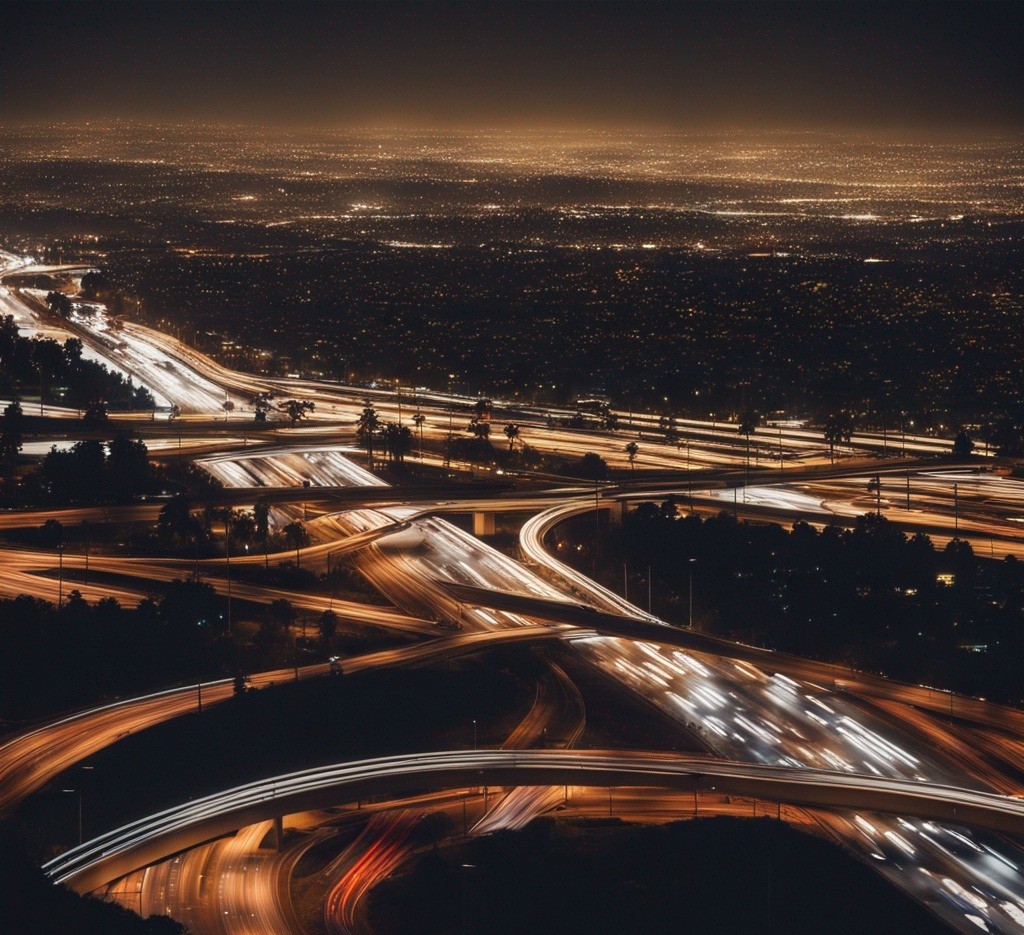Lights Below: A Journey from London to Los Angeles
The transition from London's ordered grid to LA's sprawling web of light is more than just a change in cityscape—it's a shift in perspective that begins miles above the earth.
4/27/20256 min read


There's something distinctly surreal about staring at the curve of the earth from 35,000 feet. The eleven-hour flight from London Heathrow to LAX creates its own temporary reality—a liminal space where time zones blur and the normal rules of day and night no longer apply. I've made this journey several times, but the feeling of suspension, of existing between worlds, never diminishes.
Leaving London always begins the same way. The plane climbs through layers of often-present cloud cover, that familiar British gray giving way to startling blue. The city recedes below—the Thames a silver ribbon cutting through dense urbanization, the London Eye a barely discernible speck. At night, the city presents itself as a concentrated glow, the famous landmarks illuminated like jewels on black velvet—the Tower Bridge, the Houses of Parliament, the sharp pinnacle of the Shard piercing the darkness.
The ordered nature of London's lights—following the ancient Roman roads and medieval pathways that evolved into today's streets—speaks to centuries of planned development. Even from the air, you can sense the weight of history in how the city sprawls. London grows in concentric circles, its ages mapped in light.
As we push westward, following the sunset across the Atlantic, I press my forehead against the double-paned window. The temperature on the other side is approximately -60°C, a fact the pilot mentioned casually during his welcome announcement. The contrast between the frigid outer atmosphere and the climate-controlled cabin creates a thin layer of ice crystals on the window's exterior—nature's own filter through which I watch the world pass by.
The Atlantic crossing offers little in terms of scenery—hours of darkness broken only by the occasional reflection of the moon on cloud banks or, if you're lucky, the eerie green shimmer of the Northern Lights at higher latitudes. It's during this seemingly empty stretch that the true nature of international travel settles in: the compression of distance, the technological miracle that allows us to have breakfast in Covent Garden and dinner on Venice Beach.
Sleep comes in patches, disturbed by the gentle turbulence that rattles ice in plastic cups and causes the seatbelt sign to illuminate with a soft ping. The shared experience of mild discomfort creates a peculiar camaraderie among passengers—strangers united in the collective endurance test of long-haul flight. We adjust our personal air vents, accept blankets from flight attendants, and sync our watches to a destination still thousands of miles distant.
The approach to the North American continent brings the first hint of the journey's end. The easternmost edges of Canada appear—Newfoundland and Nova Scotia presenting themselves as dark masses punctuated by small clusters of light. Then comes the unmistakable grid pattern of American cities, their perfect perpendicular streets a stark contrast to the organic growth of European urban centers.
But it's the descent into Los Angeles that delivers the most dramatic visual experience of the journey. Unlike the approach to Heathrow—often shrouded in cloud cover and drizzle—landing in LA typically offers crystalline visibility. The aircraft banks over the Pacific, and suddenly the sprawling megalopolis comes into view.
At night, Los Angeles from above is perhaps the most striking urban landscape on earth. Where London concentrates, LA expands. The city stretches impossibly far in all directions, a vast carpet of lights rolling from the ocean's edge to the distant mountains. If London's lights tell a story of history, LA's tell one of geography—following the contours of canyons, flowing through valleys, climbing hillsides only to stop abruptly at the wilderness boundaries.
Most remarkable are the freeways—arteries of white headlights and red taillights flowing like luminous blood through the city's body. From altitude, they form a web of movement, intersecting in complex interchanges that from above resemble abstract art more than transportation infrastructure. The 405, the 101, the 10—concrete rivers carrying thousands of individual stories in either direction.
As the plane descends, details emerge from the tapestry of light. The concentrated brightness of Downtown. The orderly streets of Beverly Hills. The Santa Monica Pier extending into the blackness of the Pacific, its Ferris wheel a circle of colored lights spinning slowly against the darkness. The Hollywood sign, illuminated against the hillside, an instant reminder of the city's primary industry and global identity.
The aircraft banks again, aligning with the runway at LAX. Through the window, the immensity of the city becomes even more apparent. Los Angeles doesn't end—it simply fades into the distance, merging with neighboring communities until the entire basin glows as one enormous, interconnected entity. There is no single center, no clear boundary. It is a city defined by its vastness, its decentralization a fundamental part of its character.
The landing gear deploys with a mechanical grunt. The plane descends through the last few thousand feet, close enough now to make out individual buildings, swimming pools glowing turquoise in backyard gardens, palm trees silhouetted against the night sky. There's a particular quality to the Los Angeles light—a warm amber that seems to rise from the city itself, creating a dome of illumination visible from miles away.
Touch down comes with the expected jolt, the engines reversing thrust with a roar as we rejoin the earth. Taxiing to the terminal provides the final transition from aerial observer to ground-level participant. The enormity of the city, so apparent from above, now manifests in a different way—in the knowledge that any destination within that vast grid could be an hour's drive or more, despite appearing so close from altitude.
Stepping from the climate-controlled cocoon of the aircraft into the terminal, the first sensation is the quality of the air—warmer than London, certainly, but with a distinct character that speaks immediately of California. Even filtered through the airport's ventilation system, there's something unmistakably different about it—drier, somehow lighter.
Outside the terminal, Los Angeles greets new arrivals with its characteristic contradictions. The air smells simultaneously of jet fuel, flowering plants, and the ocean—though the latter lies miles away. The night sky, which from the air appeared black and star-filled, now reveals itself to be a deep navy blue, the stars obscured by the very light pollution that made the cityscape so spectacular from above.
The journey from airport to accommodation offers the first ground-level glimpse of what was previewed from the air. The freeways that appeared as rivers of light now become concrete canyons, their scale only truly appreciable when surrounded by multiple lanes of traffic moving at speeds that would be unthinkable on British roads. The sprawl that seemed so cohesive from above now reveals itself as a collection of distinct neighborhoods, each with its own character—Inglewood giving way to Culver City, to West LA, each transition subtle but unmistakable to the observant traveler.
What strikes me most forcefully, having made the journey from London to Los Angeles multiple times, is not just the contrast between the cities themselves, but between the experiences of observing them from above versus moving through them at ground level. From the air, patterns emerge that remain invisible to those within them. The seemingly chaotic sprawl of LA reveals itself as a logical response to the geography of the basin. The freeways that frustrate drivers daily transform into elegant solutions for connecting distant communities.
As jetlag sets in and sleep becomes a distant memory, there's a curious doubling of perception—the remembered vision of the city from altitude overlaying the immediate experience of being within it. Standing on a hotel balcony, looking out at the same lights that were merely specks from the airplane window hours before, creates a cognitive adjustment that feels almost physical in nature.
This is the true gift of the journey from London to Los Angeles—not just the destination, but the shift in perspective. To see a place from above before experiencing it from within creates a mental map impossible to achieve any other way. The memory of that web of light, stretching to the horizon in all directions, provides context for every subsequent journey within the city.
Tomorrow, I'll join those rivers of headlights, become one more anonymous vehicle navigating the concrete arteries I admired from above. But something of that aerial perspective remains—a knowledge that each journey, however frustrating in the moment, forms part of a greater pattern, a living system visible only to those fortunate enough to have seen it from the unique vantage point that only flight provides.
For now, though, I stand at the window, watching the same lights that watched me arrive, the city pulsing with energy that never fully dissipates, even in the darkest hours before dawn. Los Angeles at night, from any angle, remains a testament to human determination to push back the darkness—creating, in the process, one of the most spectacular artificial landscapes on Earth.
Get in touch


